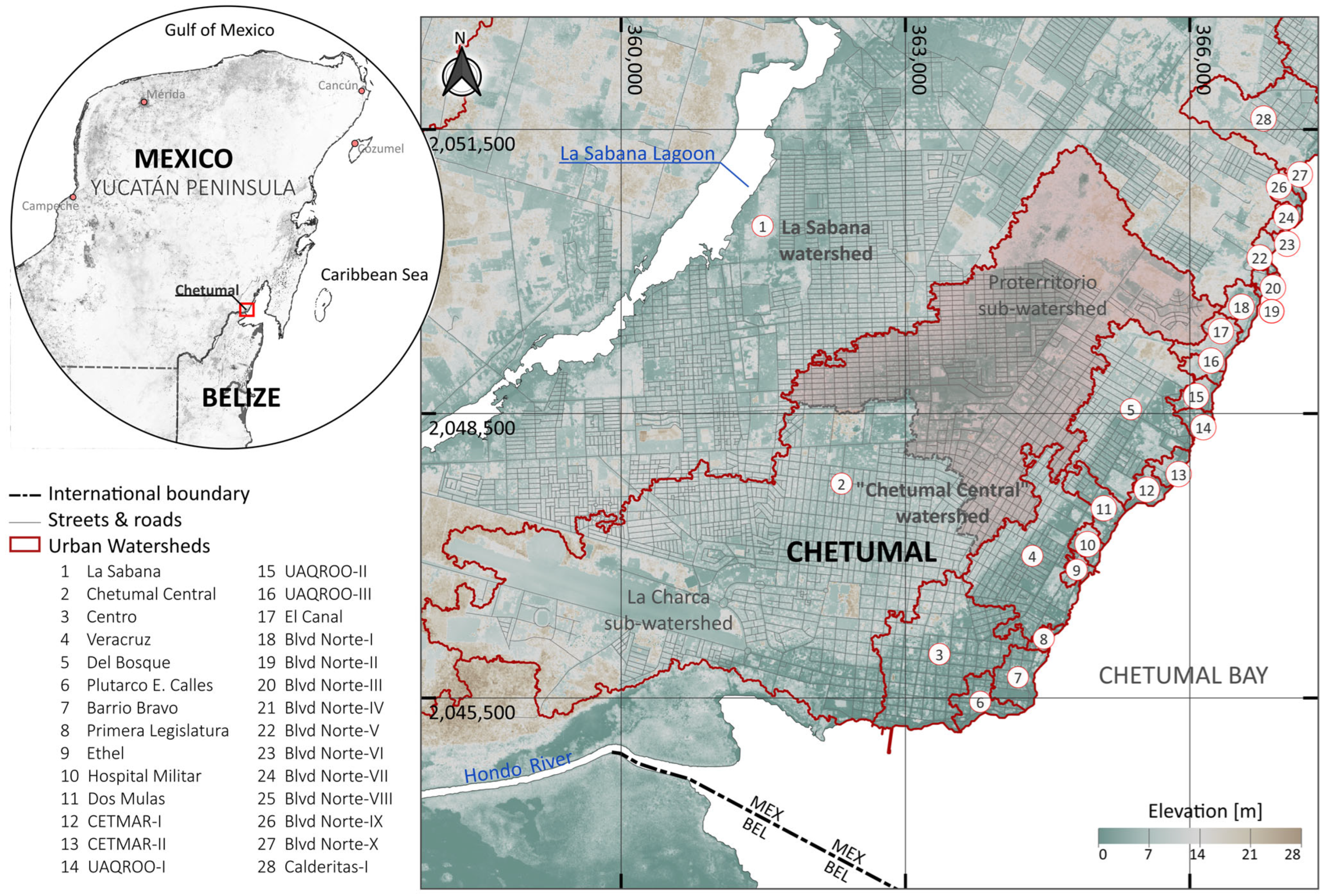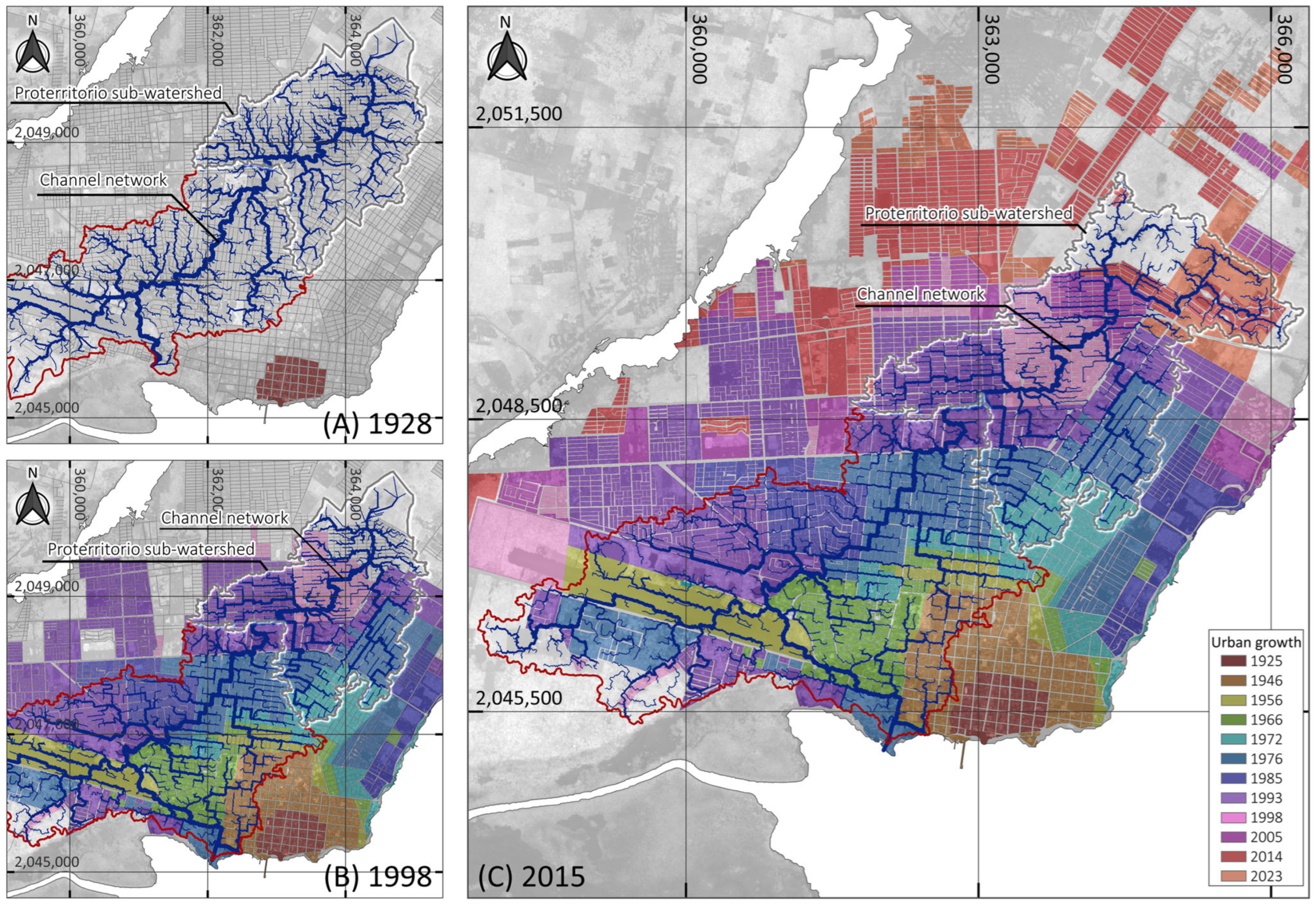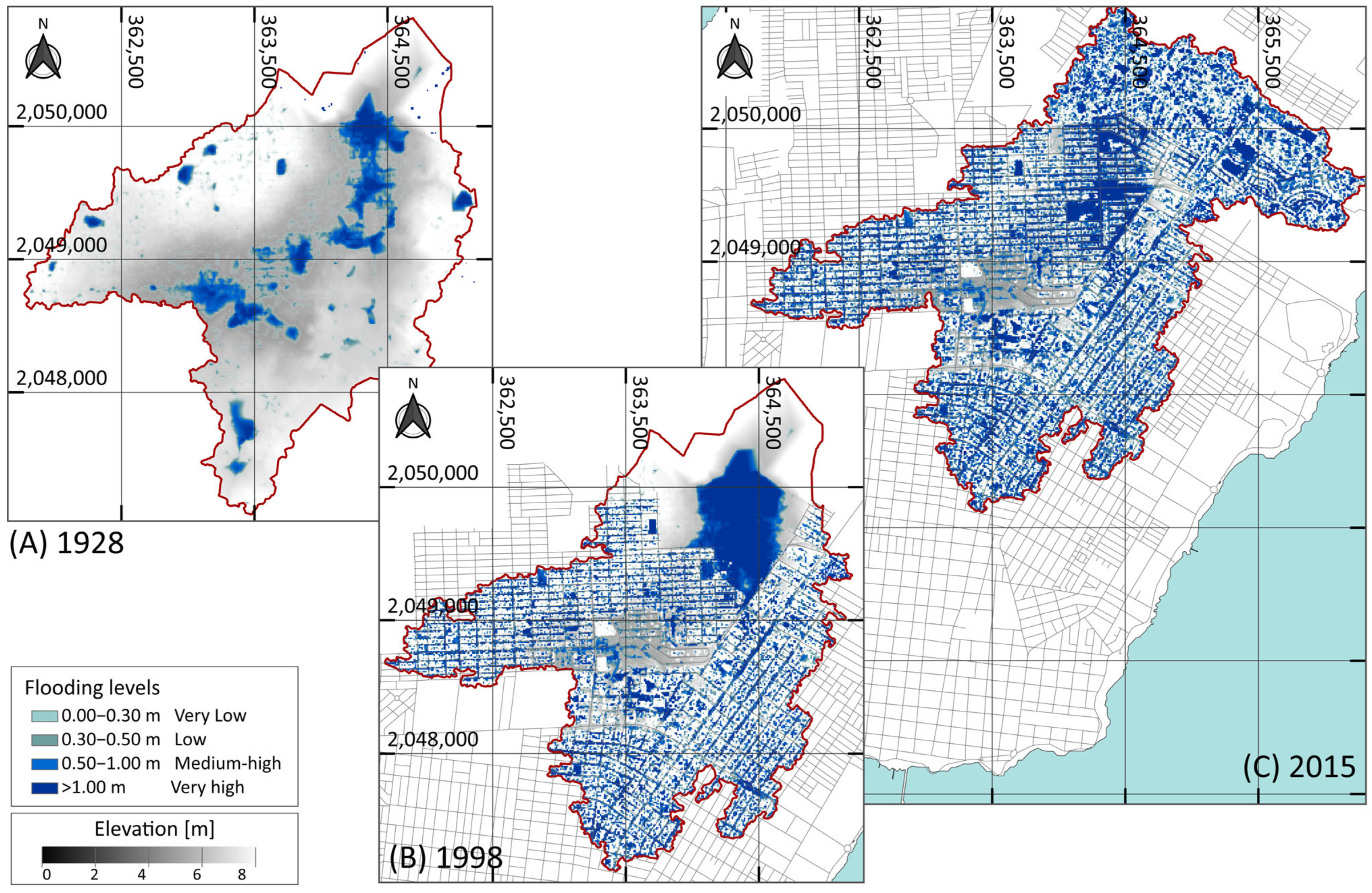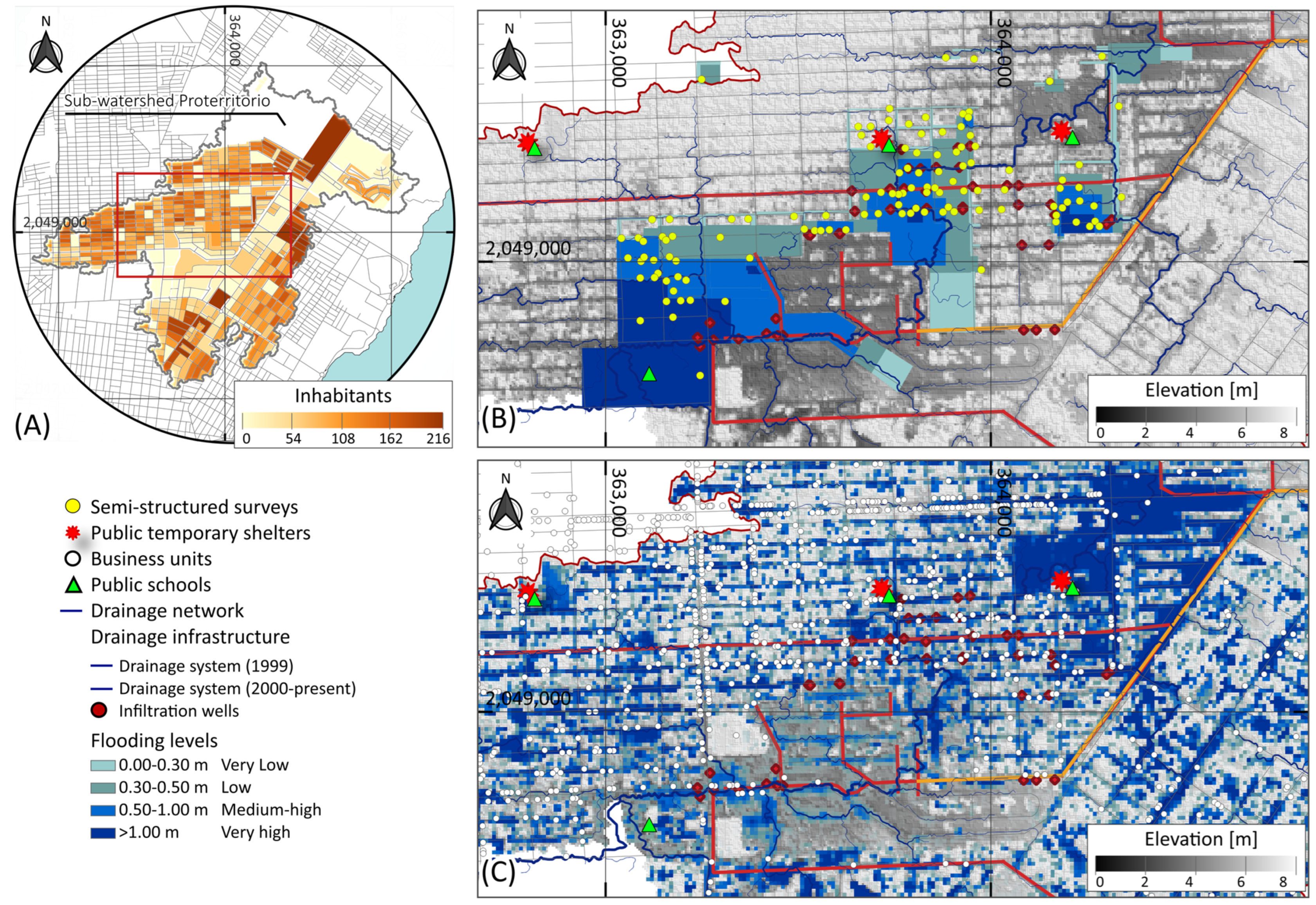Hydrological Transformation and Societal Perception of Urban Pluvial Flooding in a Karstic Watershed: A Case Study from the Southern Mexican Caribbean
Abstract
1. Introduction
2. Materials and Methods
2.1. Study Area
2.2. Data Collection and Hydrographic Modeling
3. Results
3.1. Transitioning from Nature to Urban: Historical Urban Records
3.2. Modeling of Flood Scenarios
3.3. Social Memory and Perception of UPF Events
4. Discussion
5. Conclusions
- ▪
- Karstic urban watersheds should be conceptually treated as endorheic systems that may evolve into an exorheic condition due to urbanization. Traditional regional knowledge has primarily focused on their endorheic character, overlooking recent reductions in infiltration caused by land cover changes.
- ▪
- Urban expansion has reshaped runoff dynamics, developed new flood-prone areas, and introduced unexpected hydrological constraints (e.g., damming effects that further cause large water accumulation over the urban limits).
- ▪
- The critical UPF event analyzed demonstrates that coastal urban areas are vulnerable not only to coastal or hurricane-related flooding, but also to increasingly frequent and intense pluvial events.
Author Contributions
Funding
Data Availability Statement
Acknowledgments
Conflicts of Interest
References
- Rentschler, J.; Salhab, M.; Jafino, B.A. Flood Exposure and Poverty in 188 Countries. Nat. Commun. 2022, 13, 3527. [Google Scholar] [CrossRef] [PubMed]
- Glas, H.; Rocabado, I.; Huysentruyt, S.; Maroy, E.; Salazar Cortez, D.; Coorevits, K.; De Maeyer, P.; Deruyter, G. Flood Risk Mapping Worldwide: A Flexible Methodology and Toolbox. Water 2019, 11, 2371. [Google Scholar] [CrossRef]
- Manandhar, B.; Cui, S.; Wang, L.; Shrestha, S. Urban Flood Hazard Assessment and Management Practices in South Asia: A Review. Land 2023, 12, 627. [Google Scholar] [CrossRef]
- Prokić, M.; Savić, S.; Pavić, D. Pluvial Flooding in Urban Areas across the European Continent. Geogr. Pannonica 2019, 23, 216–232. [Google Scholar] [CrossRef]
- Van der Borght, R.; Pallares-Barbera, M. Greening to Shield: The Impacts of Extreme Rainfall on Economic Activity in Latin American Cities. Glob. Environ. Chang. 2024, 87, 102857. [Google Scholar] [CrossRef]
- Cea, L.; Sañudo, E.; Montalvo, C.; Farfán, J.; Puertas, J.; Tamagnone, P. Recent Advances and Future Challenges in Urban Pluvial Flood Modelling. Urban Water J. 2025, 22, 149–173. [Google Scholar] [CrossRef]
- Pinos, J.; Quesada-Román, A. Flood Risk-Related Research Trends in Latin America and the Caribbean. Water 2021, 14, 10. [Google Scholar] [CrossRef]
- Sandoval, V.; Sarmiento, J.P. A Neglected Issue: Informal Settlements, Urban Development, and Disaster Risk Reduction in Latin America and the Caribbean. Disaster Prev. Manag. Int. J. 2020, 29, 731–745. [Google Scholar] [CrossRef]
- Othmer, F.J.; Becker, D.; Schulte, L.M.; Greiving, S. A Methodological Approach to Municipal Pluvial Flood Risk Assessment Based on a Small City Case Study. Sustainability 2020, 12, 10487. [Google Scholar] [CrossRef]
- Azizi, K.; Diko, S.K.; Saija, L.; Zamani, M.G.; Meier, C.I. Integrated Community-Based Approaches to Urban Pluvial Flooding Research, Trends and Future Directions: A Review. Urban Clim. 2022, 44, 101237. [Google Scholar] [CrossRef]
- Rosenzweig, B.R.; McPhillips, L.; Chang, H.; Cheng, C.; Welty, C.; Matsler, M.; Iwaniec, D.; Davidson, C.I. Pluvial Flood Risk and Opportunities for Resilience. WIREs Water 2018, 5, e1302. [Google Scholar] [CrossRef]
- Fowler, H.J.; Ali, H.; Allan, R.P.; Ban, N.; Barbero, R.; Berg, P.; Blenkinsop, S.; Cabi, N.S.; Chan, S.; Dale, M.; et al. Towards Advancing Scientific Knowledge of Climate Change Impacts on Short-Duration Rainfall Extremes. Philos. Trans. R. Soc. A Math. Phys. Eng. Sci. 2021, 379, 20190542. [Google Scholar] [CrossRef]
- Singh, H.; Nielsen, M.; Greatrex, H. Causes, Impacts, and Mitigation Strategies of Urban Pluvial Floods in India: A Systematic Review. Int. J. Disaster Risk Reduct. 2023, 93, 103751. [Google Scholar] [CrossRef]
- Di Baldassarre, G.; Viglione, A.; Carr, G.; Kuil, L.; Salinas, J.L.; Blöschl, G. Socio-Hydrology: Conceptualising Human-Flood Interactions. Hydrol. Earth Syst. Sci. 2013, 17, 3295–3303. [Google Scholar] [CrossRef]
- Di Baldassarre, G. Socio-Hydrology of Floods. In Oxford Research Encyclopedia of Natural Hazard Science; Oxford University Press: Oxford, UK, 2017. [Google Scholar]
- Camargo, A.; Cortesi, L. Flooding Water and Society. WIREs Water 2019, 6, e1374. [Google Scholar] [CrossRef]
- Madani, K.; Shafiee-Jood, M. Socio-Hydrology: A New Understanding to Unite or a New Science to Divide? Water 2020, 12, 1941. [Google Scholar] [CrossRef]
- Wesselink, A.; Kooy, M.; Warner, J. Socio-hydrology and Hydrosocial Analysis: Toward Dialogues across Disciplines. WIREs Water 2017, 4, e1196. [Google Scholar] [CrossRef]
- Caretta, M.A.; Fernandez, R.; Zegre, N.; Shinn, J. Flooding Hazard and Vulnerability. An Interdisciplinary Experimental Approach for the Study of the 2016 West Virginia Floods. Front. Water 2021, 3, 656417. [Google Scholar] [CrossRef]
- Ross, A.; Chang, H. Socio-Hydrology with Hydrosocial Theory: Two Sides of the Same Coin? Hydrol. Sci. J. 2020, 65, 1443–1457. [Google Scholar] [CrossRef]
- Carey, M.; Baraer, M.; Mark, B.G.; French, A.; Bury, J.; Young, K.R.; McKenzie, J.M. Toward Hydro-Social Modeling: Merging Human Variables and the Social Sciences with Climate-Glacier Runoff Models (Santa River, Peru). J. Hydrol. 2014, 518, 60–70. [Google Scholar] [CrossRef]
- Ridolfi, E.; Mondino, E.; Di Baldassarre, G. Hydrological Risk: Modeling Flood Memory and Human Proximity to Rivers. Hydrol. Res. 2021, 52, 241–252. [Google Scholar] [CrossRef]
- Garde-Hansen, J.; McEwen, L.; Holmes, A.; Jones, O. Sustainable Flood Memory: Remembering as Resilience. Mem. Stud. 2017, 10, 384–405. [Google Scholar] [CrossRef]
- Bauer-Gottwein, P.; Gondwe, B.R.N.; Charvet, G.; Marín, L.E.; Rebolledo-Vieyra, M.; Merediz-Alonso, G. Review: The Yucatán Peninsula Karst Aquifer, Mexico. Hydrogeol. J. 2011, 19, 507–524. [Google Scholar] [CrossRef]
- Day, M. Challenges to Sustainability in the Caribbean Karst. Geol. Croat. 2010, 63, 149–154. [Google Scholar] [CrossRef]
- Gencer, E.A. An Overview of Urban Vulnerability to Natural Disasters and Climate Change in Central America & the Caribbean Region. FEEM Working Paper No. 78; 2013. Available online: https://ageconsearch.umn.edu/record/158728?v=pdf (accessed on 16 June 2025).
- Jones, I.C.; Banner, J.L. Estimating Recharge Thresholds in Tropical Karst Island Aquifers: Barbados, Puerto Rico and Guam. J. Hydrol. 2003, 278, 131–143. [Google Scholar] [CrossRef]
- Day, M. The Karstlands of Antigua, Their Land Use and Conservation. Geogr. J. 2007, 173, 170–185. [Google Scholar] [CrossRef]
- Rioja-Nieto, R.; Garza-Pérez, R.; Álvarez-Filip, L.; Ismael, M.-T.; Cecilia, E. The Mexican Caribbean: From Xcalak to Holbox. In World Seas: An Environmental Evaluation; Elsevier: Amsterdam, The Netherlands, 2019; pp. 637–653. [Google Scholar]
- INEGI Modelo Digital de Elevación Tipo Terreno/Superficie Con 5m de Resolución Derivado de Datos de Sensores Remotos Satelitales y Aerotransportados (E16A65F2, E16A65F4, E16A66A3, E16A66D1, E16A66D3, E16A76A1, E16A66A4, E16A66D2, E16A66D4, E16A66B3, E16A66E1). Available online: https://www.inegi.org.mx/app/mapas/ (accessed on 15 January 2025).
- SEDATU. Programa de Desarrollo Urbano de Chetumal, Calderitas, Subteniente López, Huay Pix y Xul-Há; H. Ayuntamiento de Othón P. Blanco, Quintana Roo-Secretaría de Desarrollo Agrario, Territorial y Urbano: Chetumal, Mexico, 2018. [Google Scholar]
- INEGI Información Demográfica y Social. Censos y Conteos de Población. Available online: https://www.inegi.org.mx/programas/ccpv/2020/ (accessed on 24 November 2024).
- Alcérreca-Huerta, J.C.; Callejas-Jiménez, M.E.; Carrillo, L. Small-Scale Energy Potential from Salinity Gradients at a Transboundary Riverine Estuary in the Yucatán Peninsula. Clean. Eng. Technol. 2022, 11, 100562. [Google Scholar] [CrossRef]
- Corrales-Suastegui, A.; Fuentes-Franco, R.; Pavia, E.G. The Mid-summer Drought over Mexico and Central America in the 21st Century. Int. J. Climatol. 2020, 40, 1703–1715. [Google Scholar] [CrossRef]
- Magaña, V.; Amador, J.A.; Medina, S. The Midsummer Drought over Mexico and Central America. J. Clim. 1999, 12, 1577–1588. [Google Scholar] [CrossRef]
- Rodríguez Alarcón, M.N. Huracán Janet y El Desastre de 1955 En Quintana Roo. Antrópica. Rev. De Cienc. Soc. Y Humanidades 2019, 5, 161–190. [Google Scholar] [CrossRef]
- Camacho-Sanabria, J.M.; Chávez-Alvarado, R.; Álvarez-Trinidad, J.A.; Velázquez-Torres, D. Index of Coastal Urban Resilience (ICURHF) When Coping with Hurricanes and Floods in the City of Chetumal, in the South East of Mexico. In GIS LATAM: First Conference, GIS LATAM 2020; Mata-Rivera, M.F., Zagal-Flores, R., Arellano Verdejo, J., Lazcano Hernandez, H.E., Eds.; Communications in Computer and Information Science; Springer: Cham, Switzerland, 2020; Volume 1276, pp. 136–150. [Google Scholar]
- Hardoy, J.; Hernández, I.; Pacheco, J.A.; Sierra, G. Institutionalizing Climate Change Adaptation at Municipal and State Level in Chetumal and Quintana Roo, Mexico. Environ. Urban. 2014, 26, 69–85. [Google Scholar] [CrossRef]
- Frausto, O.; Vazquez, A.; Arroyo, L.; Castillo, L.; Hernández, M.L. Hurricane Resilience Indicators in Mexican Caribbean Coastal Cities. Int. J. Saf. Secur. Eng. 2016, 6, 755–763. [Google Scholar] [CrossRef][Green Version]
- Hernández, M.L.; Carreño, M.L.; Castillo, L. Methodologies and Tools of Risk Management: Hurricane Risk Index (HRi). Int. J. Disaster Risk Reduct. 2018, 31, 926–937. [Google Scholar] [CrossRef]
- Martínez Méndez, A.; Travieso Bello, A.C.; Frausto Martínez, O. Resiliencia Del Sistema de Drenaje Pluvial Ante Inundaciones: Caso de Estudio Chetumal, Quintana Roo, México. Antrópica. Revista Ciencias Sociales Humanidades 2018, 4, 273–300. [Google Scholar] [CrossRef]
- Strahler, A.N. Quantitative Analysis of Watershed Geomorphology. Eos Trans. Am. Geophys. Union 1957, 38, 913–920. [Google Scholar] [CrossRef]
- Bladé, E.; Cea, L.; Corestein, G.; Escolano, E.; Puertas, J.; Vázquez-Cendón, E.; Dolz, J.; Coll, A. Iber: Herramienta de Simulación Numérica Del Flujo En Ríos. Rev. Int. Métodos Numéricos Cálculo Diseño Ing. 2014, 30, 1–10. [Google Scholar] [CrossRef]
- García-Feal, O.; González-Cao, J.; Gómez-Gesteira, M.; Cea, L.; Domínguez, J.M.; Formella, A. An Accelerated Tool for Flood Modelling Based on Iber. Water 2018, 10, 1459. [Google Scholar] [CrossRef]
- Mockus, V. Hydrologic Soil Cover Complexes. In Part 630 Hydrology National Engineering Handbook; Natural Resources Conservation Service (NRCS)/Agricultural Research Service (ARS) Curve Number Work Group: Beltsville, MD, USA, 2004; p. 20. [Google Scholar]
- Mishra, S.K.; Singh, V.P. SCS-CN Method. In Soil Conservation Service Curve Number (SCS-CN) Methodology; Water Science and Technology Library; Springer: Dordrecht, The Netherlands, 2003; Volume 42, pp. 84–146. [Google Scholar]
- INEGI. Información Vectorial de Localidades Amanzanadas y Números Exteriores 2023, Othón P. Blanco. Available online: https://www.inegi.org.mx/app/mapas/ (accessed on 16 January 2025).
- Chow, V.T. Hidraulica de Canales Abiertos; McGraw-Hill: Santa fé de Bogotá, Colombia, 1994; ISBN 978-958-600-228-8. [Google Scholar]
- USBR. ACER Technical Memorandum No. 11, Assistant Commissioner—Engineering and Research, United States Bureau of Reclamation; United States Bureau of Reclamation: Denver, CO, USA, 1988; p. 57.
- Berndt, A.E. Sampling Methods. J. Hum. Lact. 2020, 36, 224–226. [Google Scholar] [CrossRef]
- Berne, A.; Delrieu, G.; Creutin, J.-D.; Obled, C. Temporal and Spatial Resolution of Rainfall Measurements Required for Urban Hydrology. J. Hydrol. 2004, 299, 166–179. [Google Scholar] [CrossRef]
- Ghosh, I.; Hellweger, F.L. Effects of Spatial Resolution in Urban Hydrologic Simulations. J. Hydrol. Eng. 2012, 17, 129–137. [Google Scholar] [CrossRef]
- Ichiba, A.; Gires, A.; Tchiguirinskaia, I.; Schertzer, D.; Bompard, P.; Ten Veldhuis, M.-C. Scale Effect Challenges in Urban Hydrology Highlighted with a Distributed Hydrological Model. Hydrol. Earth Syst. Sci. 2018, 22, 331–350. [Google Scholar] [CrossRef]
- Li, J.; Wong, D.W.S. Effects of DEM Sources on Hydrologic Applications. Comput. Environ. Urban Syst. 2010, 34, 251–261. [Google Scholar] [CrossRef]
- Muthusamy, M.; Casado, M.R.; Butler, D.; Leinster, P. Understanding the Effects of Digital Elevation Model Resolution in Urban Fluvial Flood Modelling. J. Hydrol. 2021, 596, 126088. [Google Scholar] [CrossRef]
- Huang, Q.; Wang, J.; Li, M.; Fei, M.; Dong, J. Modeling the Influence of Urbanization on Urban Pluvial Flooding: A Scenario-Based Case Study in Shanghai, China. Nat. Hazards 2017, 87, 1035–1055. [Google Scholar] [CrossRef]
- Feng, B.; Zhang, Y.; Bourke, R. Urbanization Impacts on Flood Risks Based on Urban Growth Data and Coupled Flood Models. Nat. Hazards 2021, 106, 613–627. [Google Scholar] [CrossRef]
- Bruwier, M.; Maravat, C.; Mustafa, A.; Teller, J.; Pirotton, M.; Erpicum, S.; Archambeau, P.; Dewals, B. Influence of Urban Forms on Surface Flow in Urban Pluvial Flooding. J. Hydrol. 2020, 582, 124493. [Google Scholar] [CrossRef]
- Mediero, L.; Soriano, E.; Oria, P.; Bagli, S.; Castellarin, A.; Garrote, L.; Mazzoli, P.; Mysiak, J.; Pasetti, S.; Persiano, S.; et al. Pluvial Flooding: High-Resolution Stochastic Hazard Mapping in Urban Areas by Using Fast-Processing DEM-Based Algorithms. J. Hydrol. 2022, 608, 127649. [Google Scholar] [CrossRef]
- Li, X.; Willems, P. A Hybrid Model for Fast and Probabilistic Urban Pluvial Flood Prediction. Water Resour. Res. 2020, 56, e2019WR025128. [Google Scholar] [CrossRef]
- Schmitt, T.G.; Scheid, C. Evaluation and Communication of Pluvial Flood Risks in Urban Areas. WIREs Water 2020, 7, e1401. [Google Scholar] [CrossRef]
- Woods Ballard, B.W.; Udale-Clarke, H.; Illman, S.; Scott, T.; Ashley, R.; Kellagher, R. The SuDS Manual, 6th ed.; CIRIA: London, UK, 2015; ISBN 978-0-86017-760-9. [Google Scholar]
- Fletcher, T.D.; Andrieu, H.; Hamel, P. Understanding, Management and Modelling of Urban Hydrology and Its Consequences for Receiving Waters: A State of the Art. Adv. Water Resour. 2013, 51, 261–279. [Google Scholar] [CrossRef]
- Davis, A.P.; Hunt, W.F.; Traver, R.G.; Clar, M. Bioretention Technology: Overview of Current Practice and Future Needs. J. Environ. Eng. 2009, 135, 109–117. [Google Scholar] [CrossRef]
- Martín Muñoz, S.; Elliott, S.; Schoelynck, J.; Staes, J. Urban Stormwater Management Using Nature-Based Solutions: A Review and Conceptual Model of Floodable Parks. Land 2024, 13, 1858. [Google Scholar] [CrossRef]
- Vymazal, J. Constructed Wetlands for Wastewater Treatment: Five Decades of Experience. Environ. Sci. Technol. 2011, 45, 61–69. [Google Scholar] [CrossRef] [PubMed]
- Kelly, S.; Robinson, J. FD2619 Developing Urban Blue Corridors: Scoping Study; Department for Environment, Food & Rural Affairs (DEFRA): London, UK, 2011.
- Rodríguez-Rojas, M.I.; Garrido-Jiménez, F.J.; Abarca-Álvarez, F.J.; Vallecillos-Siles, M.R. Advances in the Integration of Sustainable Drainage Systems into Urban Planning: A Case Study. Sustainability 2024, 16, 2658. [Google Scholar] [CrossRef]
- Llanes Salazar, R. El Agua En Las Humanidades y Ciencias Sociales de Yucatán. Una Introducción al Dosier. Península 2024, 20, 31–43. [Google Scholar] [CrossRef]
- Checa-Artasu, M.M. Aproximación Turístico Cultural Para Un Patrimonio En Vías de Extinción: La Arquitectura Histórica En Madera de Chetumal, Quintana Roo. El Periplo Sustentable 2012, 23, 49–78. [Google Scholar]
- Alshammari, E.; Rahman, A.A.; Rainis, R.; Seri, N.A.; Fuzi, N.F.A. The Impacts of Land Use Changes in Urban Hydrology, Runoff and Flooding: A Review. Curr. Urban Stud. 2023, 11, 120–141. [Google Scholar] [CrossRef]
- Tang, J.; Liu, D.; Shang, C.; Niu, J. Impacts of Land Use Change on Surface Infiltration Capacity and Urban Flood Risk in a Representative Karst Mountain City over the Last Two Decades. J. Clean. Prod. 2024, 454, 142196. [Google Scholar] [CrossRef]
- Rivosecchi, A.; Singh, M. Small Island City Flood Risk Assessment: The Case of Kingston, Jamaica. Water 2023, 15, 3936. [Google Scholar] [CrossRef]
- Mycoo, M.A. Caribbean Island Cities. Urban Issues, Urbanization Processes and Opportunities for Transformation. In The Routledge Handbook of Urban Studies in Latin America and the Caribbean; González-Pérez, J.M., Irazábal, C., Lois-González, R.C., Eds.; Routledge: New York, NY, USA, 2022; p. 24. [Google Scholar]
- Aziz, F.; Wang, X.; Qasim Mahmood, M.; Guild, R. Wastewater Flooding Risk Assessment for Coastal Communities: Compound Impacts of Climate Change and Population Growth. J. Hydrol. 2024, 645, 132136. [Google Scholar] [CrossRef]
- Luís, S.; Pinho, L.; Lima, M.L.; Roseta-Palma, C.; Martins, F.C.; Betâmio de Almeida, A. Is It All about Awareness? The Normalization of Coastal Risk. J. Risk Res. 2016, 19, 810–826. [Google Scholar] [CrossRef]
- Pfister, C. “The Monster Swallows You”: Disaster Memory and Risk Culture in Western Europe, 1500–2000. RCC Perspect. 2011, 1, 1–23. [Google Scholar]
- Warner, J.; Wester, P.; Bolding, A. Going with the Flow: River Basins as the Natural Units for Water Management? Water Policy 2008, 10, 121–138. [Google Scholar] [CrossRef]





| Category | Water Depth [m] | Danger Description | ||
|---|---|---|---|---|
| Vehicles | Adults | Children | ||
| Very low | 0.10–0.30 | Occupants of almost any size in a passenger vehicle are not in serious danger. | An adult of almost any size is not seriously threatened by flood water. | A child of almost any size (excluding infants) is not seriously threatened by flood water. |
| Low | 0.30–0.50 | Incipient motion and limited maneuverability of passenger vehicles | ||
| Medium–High | 0.50–0.75 | Danger is based on the features of the passenger vehicle. | A loss of stability for a child and danger based on the child’s features | |
| 0.75–1.00 | ||||
| Very High | >1.00 | Occupants of almost any size in a passenger vehicle are in danger. | A loss of stability for adults and danger from flood water | A child of almost any size is in danger from flood water. |
| Land Cover Subareas, Ai | Manning Roughness [−] | CN-Value [−] | Coverage [ha] | ||
|---|---|---|---|---|---|
| 1928 | 1998 | 2015 | |||
| Open space: | |||||
| 0.030 | 39 | 0 | 248.1 | 341.1 |
| 0.060 | 55 | 585.4 | 132.2 | 86.9 |
| Impervious areas: | |||||
| 0.020 | 98 | 0 | 6.0 | 127.8 |
| 0.010 | 72 | 0 | 93.4 | 0.00 |
| 0.015 | 98 | 0 | 122.4 | 147.7 |
| Total sub-watershed area | 585.4 | 601.9 | 702.3 | ||
| Composite CNII-value | 55.0 | 60.2 | 64.2 | ||
| Sub-watershed roughness | 0.060 | 0.030 | 0.029 | ||
| Year | Flow Velocities | Time of the Flooding Event | Average | |||||
|---|---|---|---|---|---|---|---|---|
| 79 h | 100 h | 130 h | 160 h | 190 h | 220 h | |||
| 1928 | VDN,mean [m/s]: | 0.006 | 0.003 | 0.007 | 0.005 | 0.003 | 0.002 | 0.004 |
| VMS,mean [m/s]: | 0.007 | 0.007 | 0.021 | 0.015 | 0.010 | 0.009 | 0.012 | |
| VMS,max [m/s]: | 0.029 | 0.029 | 0.068 | 0.047 | 0.033 | 0.037 | 0.041 | |
| 1998 | VDN,mean [m/s]: | 0.012 | 0.009 | 0.011 | 0.009 | 0.007 | 0.012 | 0.010 |
| VMS,mean [m/s]: | 0.011 | 0.005 | 0.028 | 0.022 | 0.009 | 0.066 | 0.024 | |
| VMS,max [m/s]: | 0.241 | 0.263 | 0.457 | 0.382 | 0.608 | 0.665 | 0.436 | |
| 2015 | VDN,mean [m/s]: | 0.013 | 0.010 | 0.013 | 0.011 | 0.010 | 0.012 | 0.012 |
| VMS,mean [m/s]: | 0.020 | 0.006 | 0.042 | 0.024 | 0.010 | 0.081 | 0.031 | |
| VMS,max [m/s]: | 0.567 | 0.462 | 1.230 | 0.872 | 0.325 | 1.753 | 0.868 | |
Disclaimer/Publisher’s Note: The statements, opinions and data contained in all publications are solely those of the individual author(s) and contributor(s) and not of MDPI and/or the editor(s). MDPI and/or the editor(s) disclaim responsibility for any injury to people or property resulting from any ideas, methods, instructions or products referred to in the content. |
© 2025 by the authors. Licensee MDPI, Basel, Switzerland. This article is an open access article distributed under the terms and conditions of the Creative Commons Attribution (CC BY) license (https://creativecommons.org/licenses/by/4.0/).
Share and Cite
Valle-Queb, C.C.; Rejón-Parra, D.G.; Camacho-Sanabria, J.M.; Chávez-Alvarado, R.; Alcérreca-Huerta, J.C. Hydrological Transformation and Societal Perception of Urban Pluvial Flooding in a Karstic Watershed: A Case Study from the Southern Mexican Caribbean. Environments 2025, 12, 237. https://doi.org/10.3390/environments12070237
Valle-Queb CC, Rejón-Parra DG, Camacho-Sanabria JM, Chávez-Alvarado R, Alcérreca-Huerta JC. Hydrological Transformation and Societal Perception of Urban Pluvial Flooding in a Karstic Watershed: A Case Study from the Southern Mexican Caribbean. Environments. 2025; 12(7):237. https://doi.org/10.3390/environments12070237
Chicago/Turabian StyleValle-Queb, Cristina C., David G. Rejón-Parra, José M. Camacho-Sanabria, Rosalía Chávez-Alvarado, and Juan C. Alcérreca-Huerta. 2025. "Hydrological Transformation and Societal Perception of Urban Pluvial Flooding in a Karstic Watershed: A Case Study from the Southern Mexican Caribbean" Environments 12, no. 7: 237. https://doi.org/10.3390/environments12070237
APA StyleValle-Queb, C. C., Rejón-Parra, D. G., Camacho-Sanabria, J. M., Chávez-Alvarado, R., & Alcérreca-Huerta, J. C. (2025). Hydrological Transformation and Societal Perception of Urban Pluvial Flooding in a Karstic Watershed: A Case Study from the Southern Mexican Caribbean. Environments, 12(7), 237. https://doi.org/10.3390/environments12070237








